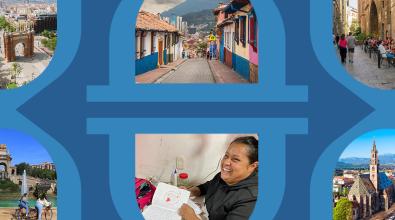To make the city more human

Only a few months after we awarded Barcelona the grand prize in our 2014 urban innovation competition, the city’s incumbent mayor, Xavier Trias, surprisingly lost his bid for reelection to Ada Colau, a 40-year-old housing activist who not only became the city’s first female mayor but also one of the most left-leaning mayors in the West.
Given Barcelona’s reputation as a global leader in ICT, it was shocking to hear Colau come out against the then-still-glittering Airbnb and question whether the city should remain as host of the Mobile World Congress. She even hit pause on our Mayors Challenge award, signaling her desire to make sure the project aligned with her emerging vision for technology and the city.
Today, Colau’s vision for urban technology is as clear as it is powerful.
“We want to make the city more human,” she explained this week, as she celebrated the citywide expansion of Vincles, Barcelona’s winning 2014 Mayor Challenge idea, which uses digital interfaces to connect aging residents with one another and to group activities. Several years and iterations after Vincles’ initial launch, evaluation now shows that the program boosts participants’ self-esteem, improves their state of mind, and creates social connections between seniors who might, otherwise, be sitting at home alone.
[Read: In Barcelona, an app to keep seniors connected]
With today’s new technologies, we need to ask, “‘What can we do to improve living conditions in our city and enhance the strength and power of our citizens?’” Colau said. “Because the [city] should not only provide better public services…. It should also empower citizens.”
Barcelona is, today, heralded as a city that is redefining what it means to be “smart,” by embracing a bottom-up strategy — where citizens own their data and inspire the ways it can stoke engagement and help the city better meet resident needs.
When it comes to this people-centered view of technology, Colau now articulates a set of ideals that I’m seeing embraced by more and more city leaders around the world. They want new technologies to enhance public value, not extract it. They believe these technologies should bring us closer to together, not split us apart. And they’re skeptical that the needs of their most vulnerable residents can win without a strong steer by local government.
And they’re right. Letting market forces have their way is a bad recipe for managing a city that works for everyone. Cities are delicate ecosystems, too.
That’s clearly what San Jose Mayor Sam Liccardo was thinking when he told technologists from the surrounding Silicon Valley that, heck yes, they were welcome to test their AV mobility products on city streets. But, he added, that was if — and only if — those products could help him increase economic mobility for vulnerable San Jose residents. The result? AV pilots in the city are now designed to help formerly homeless veterans connect to the city’s mass transit system.
Vincles, too, has become a powerful tool for helping vulnerable residents. At this week’s celebration, we heard from a number octogenarians who participate in the program’s “Joy Group” of women, which enjoys weekly excursions around the city. For them, technology has become a vital window into a world of friendships and adventure.
If they’re to make their cities more human, city leaders have to start every conversation with technologists with a reflection on what critical problem a new technology can help them solve. The newest push from Barcelona, for example, has the city partnering with the Fundació Mobile World Capital to find 5G integrations that help increase the quality of life among elderly residents living at home with cognitive impairments, like dementia.
It’s equally important that city leaders ask themselves if a new technology will bring us closer to — or further from — our shared humanity. Will it empower people to deepen their connections with one another? And, if not, is it really worth it?
We’ve gone down this road before. Through the better part of the 20th century, governments professionalized one public service after another. This had many benefits — efficiency and reliability among them — but the voice and role of citizens got squeezed out along the way. Cities are now using design and open-innovation techniques to bring the wisdom, insights, and talents of people back into the center of policy making. Others, still, are looking beyond a “professional-services first” approach to invest directly in citizens collaborating with citizens, in a strategic effort to strengthen social capital. The London borough of Barking and Dagenham stands out as a leader here.
Today, there’s a risk, as we catapult into this smart-city world, that technology will further reduce human interactions and the social resilience they engender. That would be repeating the same mistake of the past. It would make our cities less human. And no technology in the world is worth that.


